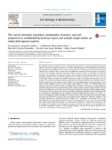Please use this identifier to cite or link to this item:
http://www.alice.cnptia.embrapa.br/alice/handle/doc/1001356| Title: | The match between microbial community structure and soil properties is modulated by land use types and sample origin within an integrated agroecosystem. |
| Authors: | LISBOA, F. J. G.  CHAER, G. M.   FERNANDES, M. F.   BERBARA, R. L. L.   MADARI, B. E.   |
| Affiliation: | GUILHERME MONTANDON CHAER, CNPAB; MARCELO FERREIRA FERNANDES, CPATC. |
| Date Issued: | 2014 |
| Citation: | Soil Biology & Biochemistry, Oxford, v. 78, p. 97-108, 2014. |
| Description: | It is of global concern to adopt measures to mitigate land degradation caused by agricultural production systems. One of the strategies proposed is to replace degraded pastures with agrosilvopastoral systems which integrate three different land-use types: crop production, livestock pasture and forestry plantation (denoted iCLF). However, little is known about the differences between iCLF and other land use types in terms of soil microbial community structure. Distance matrices based on individual soil chemical properties and individual soil microbial variables were correlated by Procrustes analysis and these re-lationships yielded vectors of residuals depicting these correlations (matches). These vectors were used as univariate response variables in an ANOVA framework in order to investigate how the match sizes (the strength of correlation/covariance) between individual soil chemical properties and individual soil mi-crobial variables vary across land use types (levels: iCLF; degradated pasture; improved pasture; and a native cerrado fragment) and also across sample origin within iCLF (levels: soil samples under morein fluence of the exotic tree forest stand; soil samples under influence of the pasture; samples within the transition between the forest stand and the pasture). We were able to obtain insights into the fact that the land use distinction can be driven by more than just individual soil chemical and microbial variables. The integration of crop, livestock and forestry promoted a dominance of fungi in this low fertility and low pH environment. P availability and the composite variable exchangeable base cations (Caþ2, Mgþ2, Kþ) were the soil properties whose strengths of correlation (match sizes) with individual microbial variables were the most affected by land use type and sampling origin within iCLF. While the strength of the correlation between soil microbial structure variables and P availability was typically land use type dependent, the response of the microbial structure to exchangeable base cations was mainly affected by the sample origin within iCLF. Finally our results point towards the conclusion that increases in the heterogeneity of vegetation within integrated crop, pasture and forestry systems are an important driver of microbial community response to environmental changes, and may be one means by which to in-crease the sustainability of tropical agroecosystems. |
| Thesagro: | Sistema de Produção Solo |
| NAL Thesaurus: | degradation soil |
| Keywords: | Degradação |
| Type of Material: | Artigo de periódico |
| Access: | openAccess |
| Appears in Collections: | Artigo em periódico indexado (CPATC)  |
Files in This Item:
| File | Description | Size | Format | |
|---|---|---|---|---|
| Lisboaetal.2014b.pdf | 1.6 MB | Adobe PDF |  View/Open |









